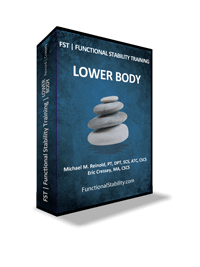 On the week of June 18, the National Track & Field Championships were held in Moncton, New Brunswick. I was here with our group from Edmonton and was fortunate to have a little downtime throughout the week. Because of this, I was able to get in a little continuing education time. That same week Mike Reinold and Eric Cressey also released their Functional Stability Training for the Lower Body as a follow up to their Functional Stability Training for the Core so naturally it was an easy fit. It's quite a lengthy program - I have yet to get through it all - but I was able to jot some notes down along the way. This summary was a culmination of several updated posts. Training the Hip for FST for the Lower Body
Assessing Lower Body Alignment and Movement (Lab)
Preparing the Adductors for Health and Performance
Hip Internal Rotation Deficits: Why You Have Them and What to Do About Them (Lab)
Training the Foot and Ankle for FST for the Lower Body
Understanding and Implementing Neuromuscular Control Progressions into Your Programs (Lecture) / How to Integrate Neuromuscular Control Progressions (Lab)
Developing Lower Extremity Strength and Power Outside the Sagittal Plane (Lab)
0 Comments
Leave a Reply. |